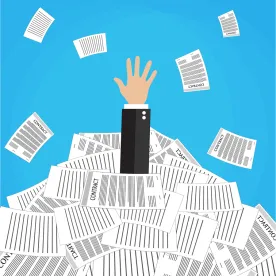Paper is cumbersome, easily lost or stolen, and expensive to store or shred. Digital documents have none of this baggage. They are quick, easy, light, and best of all, take up zero actual, physical space in an office or warehouse. This is why we need to focus on how to optimize the PDF – an acronym that technically stands for Portable Document Format, though no one uses that phrase (and very few actually know it). As a file format, though, it is hard to beat. When a document is scanned into a computer, it nearly always comes out the other end as a PDF. There are plenty of reasons for this, not the least of which is the file’s simplicity and ease of use. Since there isn’t any real paper being used, there is an immense amount of time and money that can be saved by firms employing PDF technology.
That said, there is more to it than efficiency. As the American Bar Association puts it, “PDF has moved from being the de facto standard for storing and sharing electronic documents in the legal world to the de jure standard based on its adoption for use by federal and state courts and governmental agencies.” If that wasn’t enough, the ABA goes on: “Because electronic filing is required for lawyers in the federal courts and many state courts, understanding the tools available to create PDF documents is a necessity.”
So, a PDF file is the safest and most secure way to store documents, as well as the most efficient and cost-effective. In a field where security and safety are paramount to success (overhead nearly always needs to be mitigated), one would be hard-pressed to find a reason not to use PDFs in their legal practice. Considering that electronic legal documentation is even required federally and by some states, as the ABA writes, it is vital that attorneys get up to speed with the technology and the means to use them effectively.
The practical benefits of a PDF are endless.
There used to be just one major PDF application, Adobe Acrobat (the same makers of Photoshop), but that has changed dramatically in the past few years. The market today is flooded with PDF storage and markup tools, which has brought the barrier to entry down both in terms of cost and the technical learning curve required to develop mastery of the file format.
Keep this one simple principle in mind when dealing with PDFs: if it can be done with paper, it can also be done with a PDF. Keep this second principle in mind, too: the reverse is not the case. In other words, PDFs can do everything paper can, and much more. Computers are certainly more versatile than a pen and paper ever could be, for a million and one reasons. PDFs function in the same way, but in a narrower sense.
If an attorney needs to remove metadata, add redactions, organize multiple case files into one document, create a fillable form, highlight, make comments, create any number of annotations, it can all be done on a PDF with the right software. Adobe Acrobat is still the industry leader, but, as mentioned, it is not the only show in town anymore. Other great PDF applications are GoodReader, iAnnotate, and PDF Expert by Readdle.
Summary
Technology is certainly the future, and PDFs are an integral part of that for anyone involved in the legal profession. Attorneys are required to utilize digital documentation and filing. In the near future, the paper could legitimately become a thing of the past. Law firms would do well to be ahead of that particular curve.




 />i
/>i

